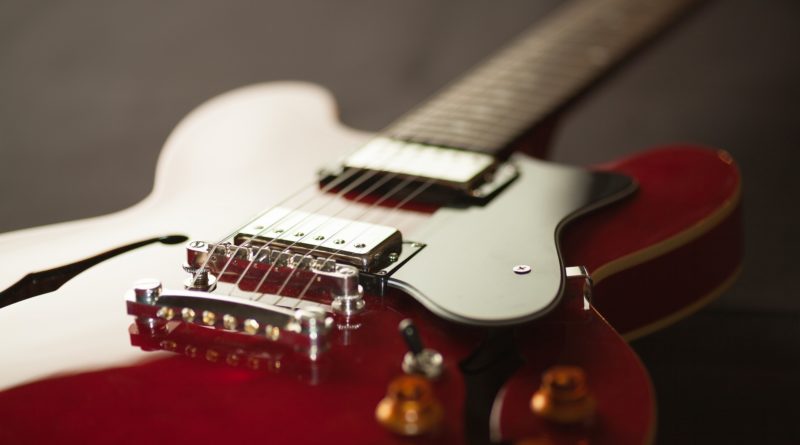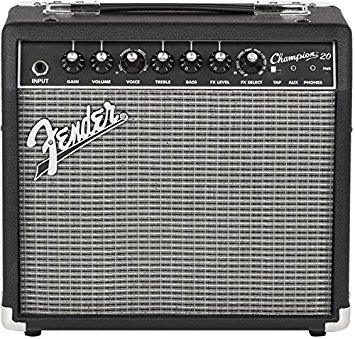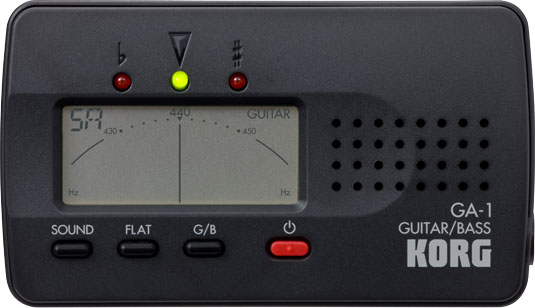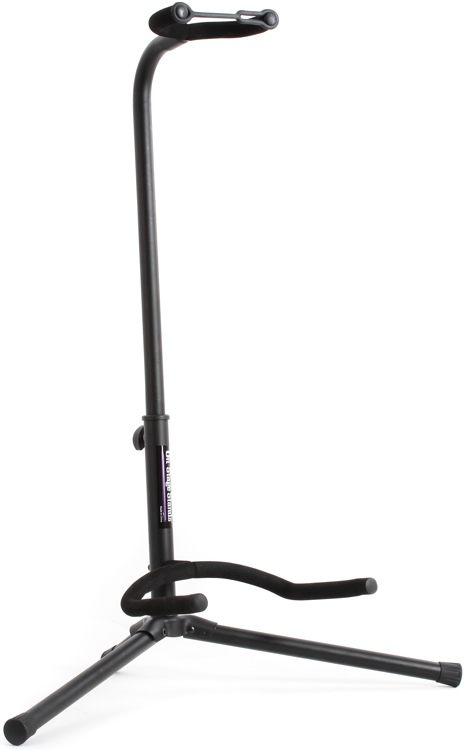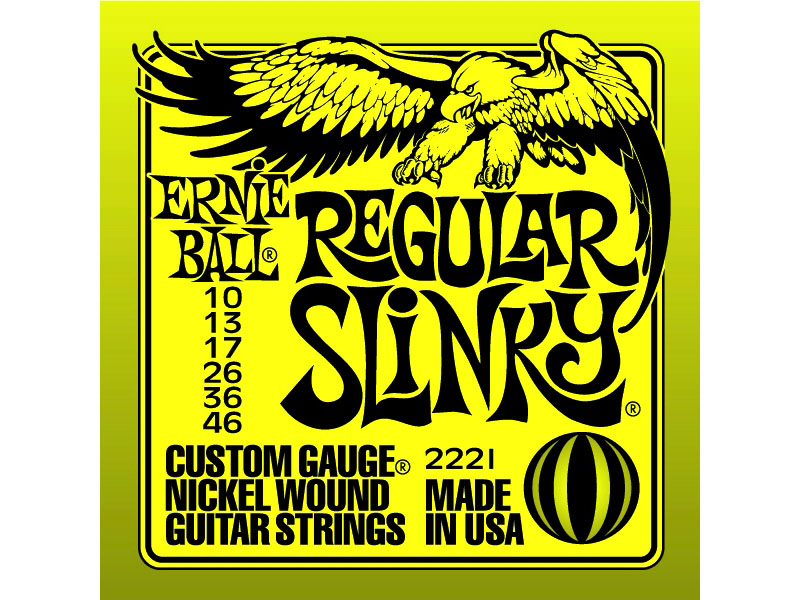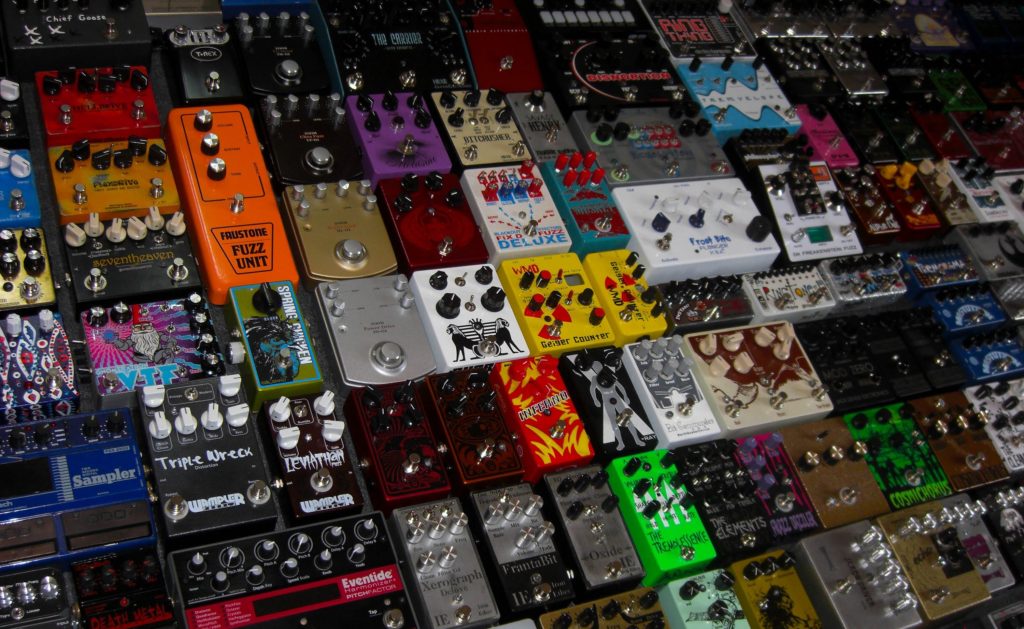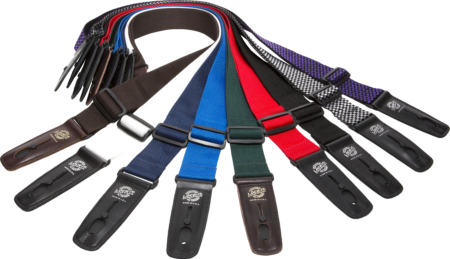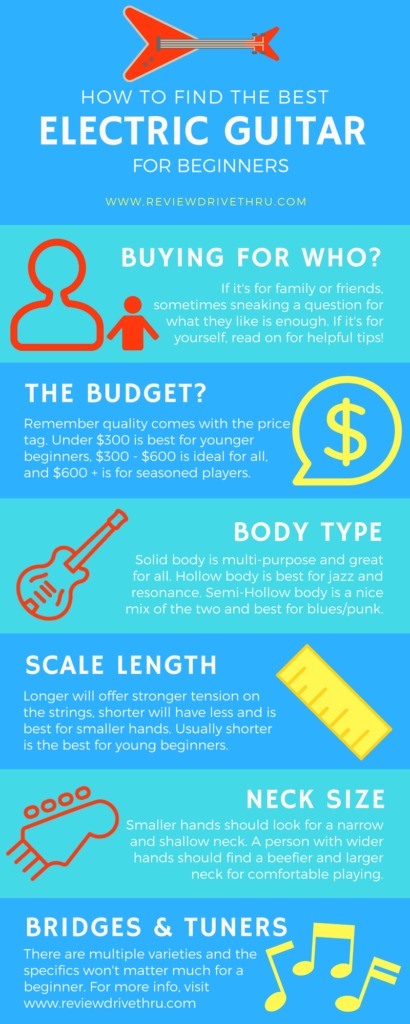Top 5 Best Electric Guitars For Beginners
Table of Contents:
- Introduction
- Beginner Guitar Options
- Fender Stratocaster
- Epiphone Les Paul
- Fender Telecaster
- Epiphone SG Style
- Ibanez Metal Style
- Extras
- Infographic and Buyers Guide Summary
- Conclusion and Comments
Introduction:
It can be a daunting task to find a good electric guitar for a fair price. 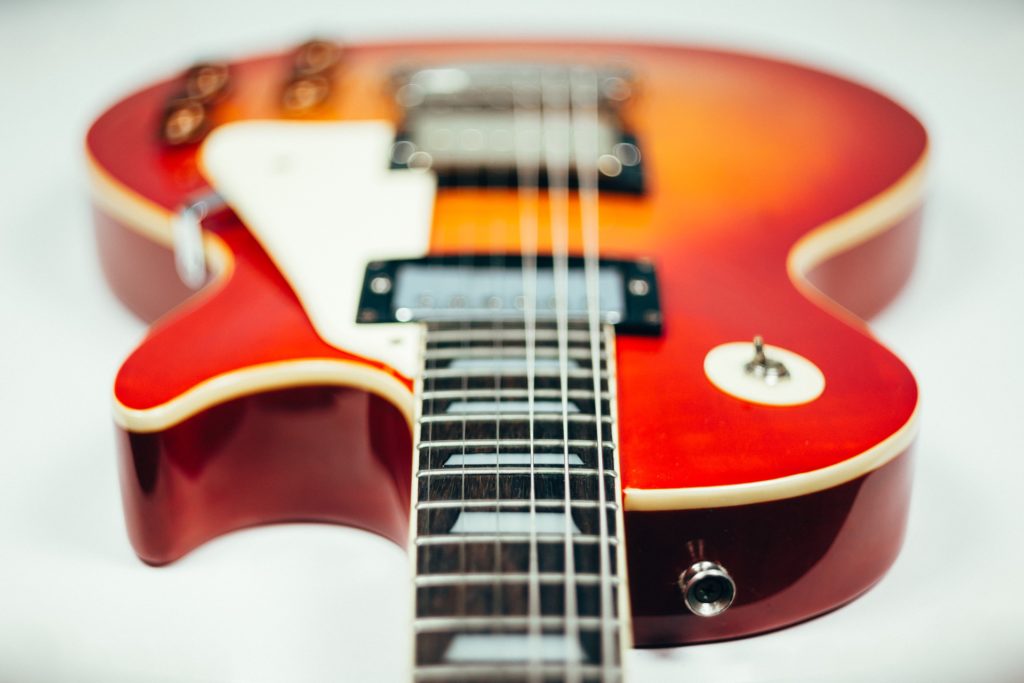
Especially finding an electric guitar for a beginner and getting it from a reputable brand.
This short guide is here to help solve that problem and offer a few suggestions to ease your search. They are sorted by their style and a recommended version of each for beginners with a few details.
Lets get to it!
Electric Guitar Comparison Table
| Brand | Budget Range | Body Type | Scale Length | Neck Shape | Check Prices |
| Fender | Under $300 | Stratocaster | 25.5″ | “C” Shape | Check Prices |
| Epiphone | Under $300 | Les Paul | 24.75″ | SlimTaper | Check Prices |
| Fender | $300-$600 | Telecaster | 25.5″ | “C” Shape | Check Prices |
| Epiphone | Under $300 | SG Style | 24.75″ | SlimTaper D | Check Prices |
| Ibanez | Under $300 | Metal Style | 25.5″ | SA | Check Prices |
Now to take a look at each individual guitar, it’s pros and cons, and if it’s the right electric guitar for a beginner.
Fender Stratocaster – The Beginner Go To Electric Guitar
For genres: Rock, Blues, Pop, Indie, Funk, Country
Obviously the stratocaster is used in multiple genres of music. 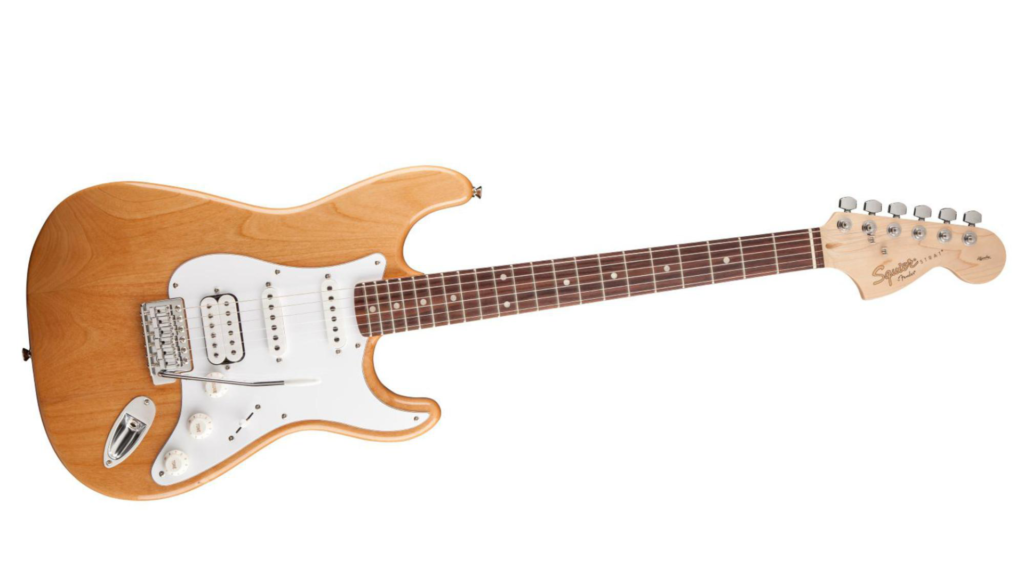
This is why it’s so commonly seen in a beginners and even professionals hands. It is diverse, easy to play, and still has a nice sleek look.
It also comes equipped with a whammy bar, tone adjustments, and volume adjustments on the body. If you’re curious of the pickups, it comes with a standard humbucking bridge pickup and single-coil strat middle and neck pickups. The switching between these pickups is a simple switch on the body. This guitar is the ideal pick for beginners because of all of these features. It is affordable, easy to play, and comes with so many extra options to help learn.
Overall, this is the first one reviewed because it’s the best option for any beginner. The other styles have subtle differences in appearance and different features. Which in some cases don’t compare, since the Fender Stratocaster has all extras a beginner could ask for at an affordable price.
Fender Stratocaster Specifications:
- Body Shape: Stratocaster
- Neck Shape: “C” Shape
- Scale Length: 25.5″ (648mm)
- Fingerboard Radius: 9.5″ (241mm)
- Number of Frets: 21
- Fret Size: Medium-Jumbo
- Bridge Pickup: Standard Humbucking
- Middle Pickup: Standard Single-Coil Strat
- Neck Pickup: Standard Single-Coil Strat
- Controls: Master Volume, Tone 1. (Neck Pickup), Tone 2. (Middle Pickup)
- Pickup Switching: 5-Position Blade
- Tremolo Arm Handle: Standard Tremolo Arm
- Multiple features to assist any beginner.
- Five-way pickup switching
- Very affordable
- Long scale length
Fender Stratocaster
Epiphone Les Paul – The Sleekest Guitar Ever!
For genres: Rock, Metal, Blues
There is a very notable history behind the Les Paul electric guitar style 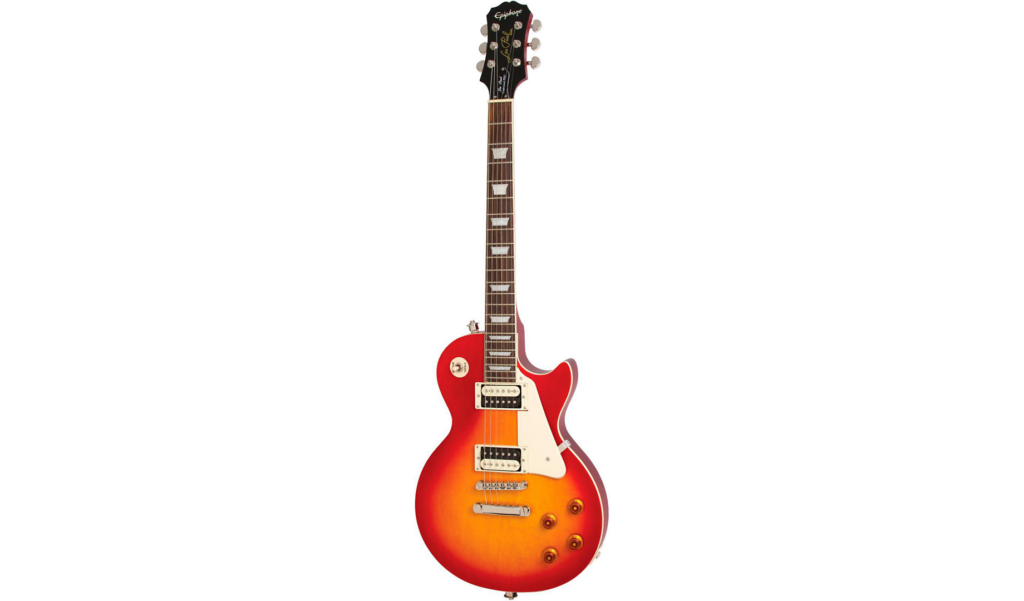
This is a guitar style that can be either affordable, or a top of the line model made for a professional. While great to have as a beginner, it’s an optimum choice for the advancing guitarist looking to improve.
Noteable features of this Les Paul include the 700T/650R open-coil humbucker pickups and mahogany body that will deliver a solid classic tone. Additionally, the scale length is shorter that the Fender Stratocaster by 3/4″ and has an additional fret with a total count of 22.
Altogether, Epiphone is a reliable company that has been around a little over a century. Their tone of the Les Paul 100 comes from two Alnico V Humbucker pickups with tone and volume controls for each. It has a 3-way pickup switch (2 less options than the Stratocaster) and a phenomenal rosewood fingerboard. The Les Paul is a perfect choice for a guitarist of any level. So if you want to buy a new electric guitar for a beginner and want to ensure they’ll keep it for a long time, the Les Paul is the way to go!
Epiphone Les Paul Specifications:
- Body Shape: Single Cutaway
- Neck Shape: SlimTaper
- Scale length: 24.75″
- Fingerboard Radius: 12″
- Number of Frets: 22
- Fret Size: Medium-Jumbo
- Bridge Pickup: 700T
- Neck Pickup: 650R
- Controls: Volume 1, Volume 2, Tone 1, Tone 2
- Pickup Switching: 3-Way switch
- Suitable for beginner and advanced players
- Shorter scale length with more frets
- Slight increase in price
Epiphone Les Paul
Fender Telecaster – The Squier Affinity Series
For genres: Rock, Indie, Country
Created in the 1950’s and still going strong today, the Telecaster has effectively withstood the test of time. 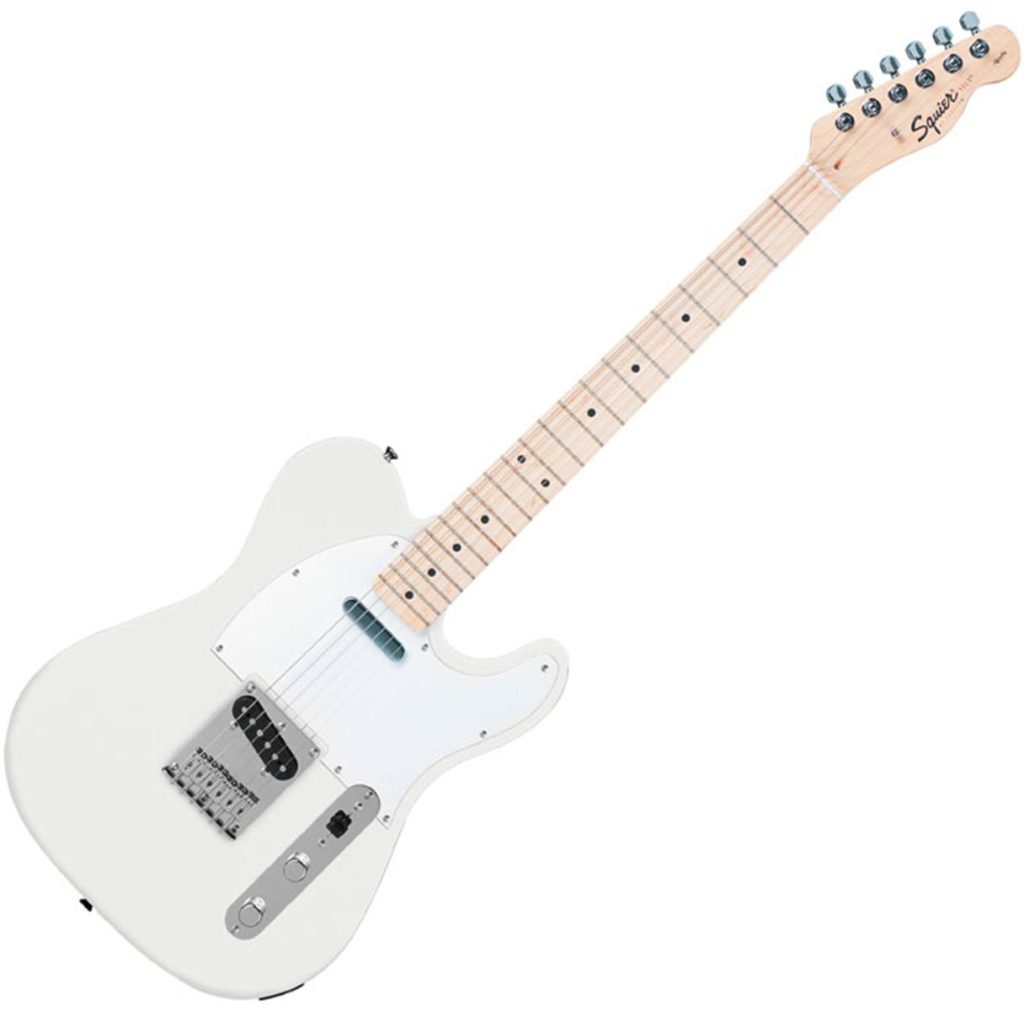
There have been multiple famous guitarists who have chosen the Telecaster as their choice of guitar, including Brad Paisley, Bruce Sprinsteen, Keith Richards, and numerous others.
It comes with a pine body that perfectly resonates and provides a one of a kind tone similar to early Esquire guitars.
Overall, the Telecaster is a great option for beginners, especially if they have plans on getting into customizing their guitars. The Telecaster is easy to work on, provides a classic vibe, and is also easy on the wallet.
Fender Telecaster Specifications:
- Body Shape: Telecaster
- Neck Shape: “C” Shape
- Scale Length: 25.5″ (648mm)
- Fingerboard Radius: 9.5″ (241mm)
- Number of Frets: 21
- Fret Size: Medium-Jumbo
- Bridge Pickup: Custom Telecaster pickup (Alnico 5 on Butterscotch Blonde/Alnico III on Vintage Blonde)
- Neck Pickup: Custom Telecaster pickup (Alnico 5 on Butterscotch Blonde/Alnico III on Vintage Blonde)
- Controls: Volume, Tone
- Pickup Switching: 3-Position Blade
- Holds a tune very well
- Easily customize
- Very affordable
- Not as comfortable as a Stratocaster
- Thinner sound
Fender Telecaster
Epiphone SG-Special Electric Guitar
For genres: Rock and Blues
Next up, the SG Style! It is appreciated by many rock guitarists for it’s very audible “snap” and jangle tone. 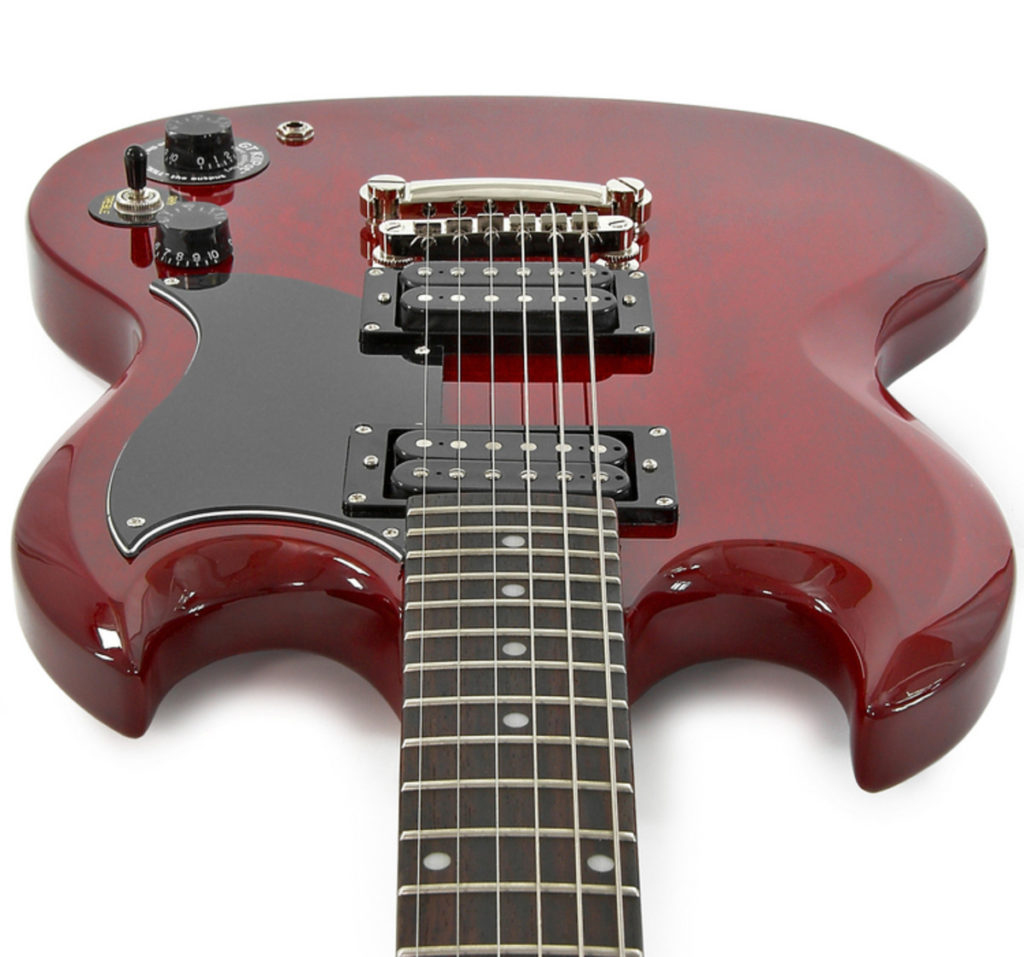
It also has features including two open-coil humbuckers, an innovative integrated killswitch/tone pot, LockTone tune-o-matic bridge and stopbar tailpiece for more sustain and easier string hardware changing.
More importantly, because of the way the neck connects to the body, the SG offers excellent access to the entire fretboard, making it great for soloing. And if you’re looking to learn how to play standing, the SG Style is much lighter than a Les Paul. Their light weight makes them easily resonant and responsive to what’s coming from your amplifier.
A big take away from the SG is that it’s great for smaller rock and roll players that don’t want something heavy to tote around. Also, it does have a short scale length coming in at 24.75″, making it great for beginners, but may not be preferred for die hard metal players.
Epiphone SG Style Specifications:
- Body Shape: SG Style
- Neck Shape: SlimTaper “D”
- Scale Length: 24.75″
- Fingerboard Radius: 12″
- Number of Frets: 22
- Fret Size: Medium
- Bridge Pickup: 700T Humbucker
- Neck Pickup: 650R Humbucker
- Controls: 1-Master volume, 1 Master-tone with KillPot
- Pickup Switching: 3-Way
- Great for soloing
- Shorter scale length for beginners
- Epiphone version is affordable
- The appearance can be a bit harsh
- Doesn’t hold tune as well as others
Epiphone SG Style
Ibanez Metal Style – For The Hard Rocker
For genres: Metal and Rock
The first Ibanez on the list! Another reliable and trustworthy brand known for quality. 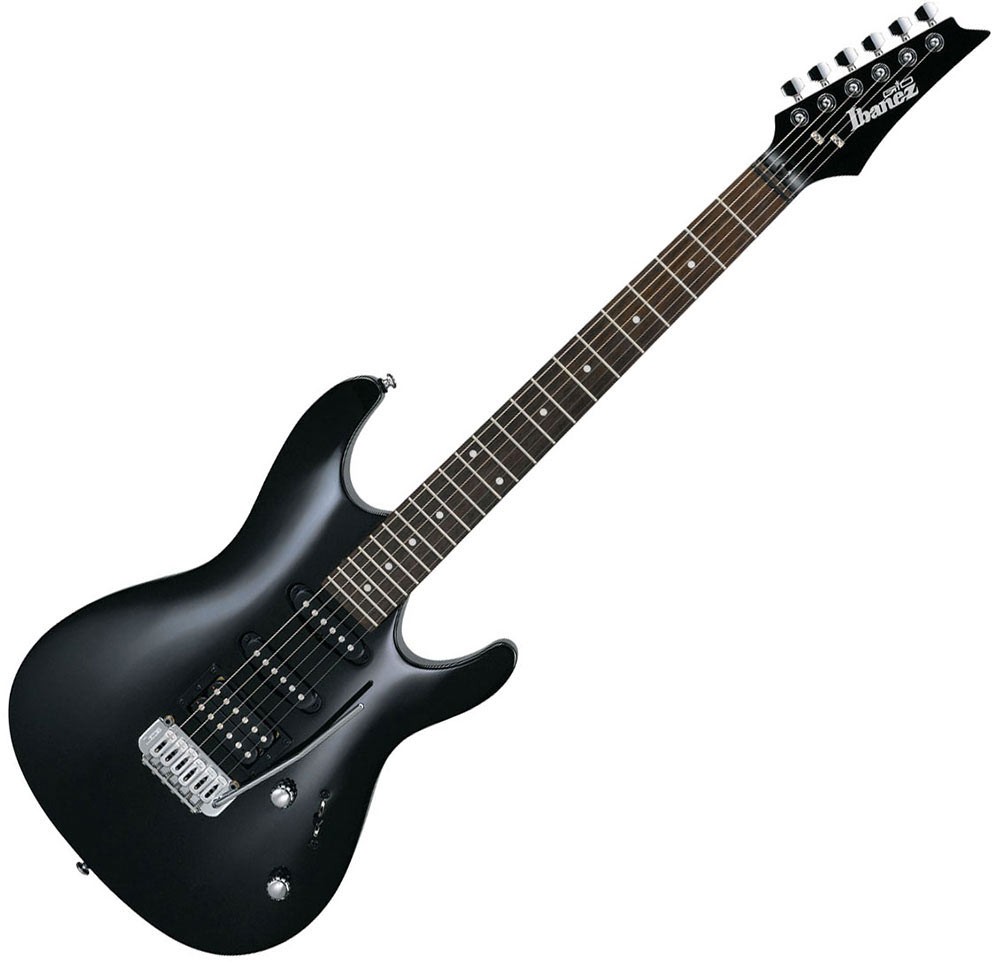
The GSA60 is the choice to go for if you’re looking to find a guitar for a “metal head”. Most metal lovers prefer a long scale length and a wide variety of controls to play around with. The Metal Style fills those needs perfectly!
It comes equipped with 3 pickups, 5-way switch blade, 22 frets, and 25.5″ scale length. Keep in mind that like all guitars it has it’s drawbacks though! Get this guitar if you want something you might want to customize and add your own pickups and want the metal look. Otherwise, you can get the Stratocaster above for a similar price range and features.
Even searching through the internet will reveal the downsides of the Metal Style, but always comment on how it’s the best value for the price. Just remember this review is meant for beginner guitars, you won’t be playing Madison Square Garden with this, but it’s the best to grow into for it’s genre.
Ibanez Metal Style Specifications:
- Body Shape: Metal Style
- Neck Shape: SA
- Scale Length: 25.5″
- Fingerboard Radius: 15.75″
- Number of Frets: 22
- Fret Size: Medium
- Bridge Pickup: Humbucker
- Neck Pickup: Single-Coil
- Controls: Volume
- Pickup Switching: 5-Position Blade
- Great for metal heads
- Best bang for your buck for starting out in metal
- Stock pickups aren’t perfect
- Whammy bar takes out of tune quickly
Ibanez Metal Style
Guitar Extras and Must Haves
1. Amplifier and Cables – Any electric guitar is going to need a proper amp to be heard. While you can hear the ping and tang without one, the purpose is to really experience playing, so you’ll need an amp. If you’re looking for some recommendations then check out Guitar Fella!
2. Guitar Tuners – Being a beginner, it’s unlikely you’ll be able to tune your guitar by ear. So starting out a reliable tuner will be a must have and thankfully they aren’t too expensive. A decent tuner can be found for around $10.
3. Guitar Picks – Most finger picking guitarists use nylon or steel acoustic. Playing electric guitar, you’ll want to grab a few guitar picks to accompany you on your journey to being a rockstar. Musicians Friend offers great packs so you can have extras (some WILL get lost).
4. Guitar Stand – This is really just extra. Honestly you can just put guitar next to a wall and it’s not going to die. But if you want to prevent it falling over, I recommend buying a $10-$15 guitar stand.
5. Extra Strings – These are actually pretty important. Buying quality strings that can hold a tune are a must have. If you’re just starting out, expect to be changing your strings after only a few months. Once again, Guitar Fella offers a decent review for how to pick your first guitar strings.
6. Foot Pedal – Now we get into extras that aren’t really that necessary starting out. Most amplifiers already have a few settings and controls to adjust the sound of your guitar. but if you’re looking for great variety of sounds, then foot pedals are a nice addition.
7. Guitar Strap – Another addition that isn’t necessary to learning. Most of the time you’ll be sitting down to perfect the basics. But if you want to slowly transition to playing while standing, then a guitar strap will be needed.
Buyers Infographic Tips
Share this Image On Your Site
Buyers Guide Summary
Who are you buying for? Family, friend, yourself? Is it a gift?

Usually, the best way to handle buying a guitar for anyone else is to simply ask what their favorite kind is. If they already know then get them that, chances are they’ve already done their homework. Otherwise, continue on with the guide as if you’re buying for yourself and place yourself into their shoes.
What is your budget?

Remember that quality comes with the price tag. You can usually save money in the long run by paying a little more and getting a reliable guitar from a reputable brand.
It’s understandable to be hesitant to spend a lot on a beginners guitar. You’re not sure if the person you’re getting it for will stick with it. Also, if you’re getting it for yourself, you may not be sure if it’s really what you want, so it makes sense to be cautious on price. Just remember that the better the guitar, the more likely the player will stick with it. A guitar that won’t keep a tune or is hard to play will deter any player.
Also make sure to add an amplifier and cable to the budget. They’re essential for playing an electric guitar. While extras like a foot pedal or strap can be bought later. A beginner needs a good guitar, but a lower priced amp will work just fine for the time being. That way you save money and the new guitar player still gets a good sound.
Price Ranges:
- Under $300 – This price range is usually what you should buy for someone in their early teens who is just looking to get started. The guitars in this range aren’t masterful and will have drawbacks, but offer a great introduction and can really gauge how interested the player is in learning.
- $300-$600 -This price range usually consists of similar models as the less expensive guitars, but with additional upgrades to parts of the guitar such as the pickups, hardware, wood, or general construction practices. This is the range you want to aim for a beginner who is a little older and may find it easy to be discouraged from playing on a guitar with lower performance.
- $600 + – Going farther into this range slowly increases in quality. You begin to reach the premium options for guitars that many times would meet the needs of a professional player. If you’re buying for a beginner and absolutely want the best, then here is the place. But by no means is it suggested you try for this price range, since 300-600 is perfect for any beginner guitar player.
What body type are you looking for?
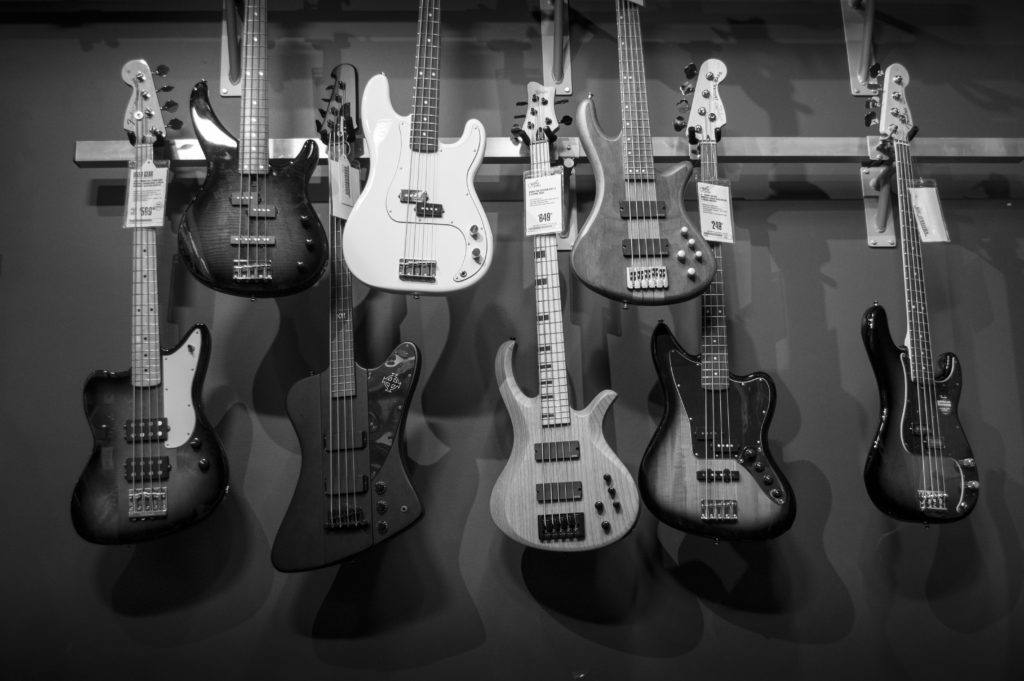
Solid body – Most common that is made from a solid slab of wood. Think of these as multi-purpose and great for beginners.
Hollow body – More resonance and preferred by jazz guitarists for their sound.
Semi-Hollow body – The in between, with a solid enter to cut down on feedback but more resonance than a solid body. Also multi-purpose, but often loved by blues guitarists and punk rock.
What about the scale length?
This being the length of the string that vibrates, measured from nut to bridge.
Longer – Usually offers a stronger tension on the strings.
Shorter – Less tension on the strings and easier for smaller hands. Definitely recommended for beginners.
Aim for the right neck size!
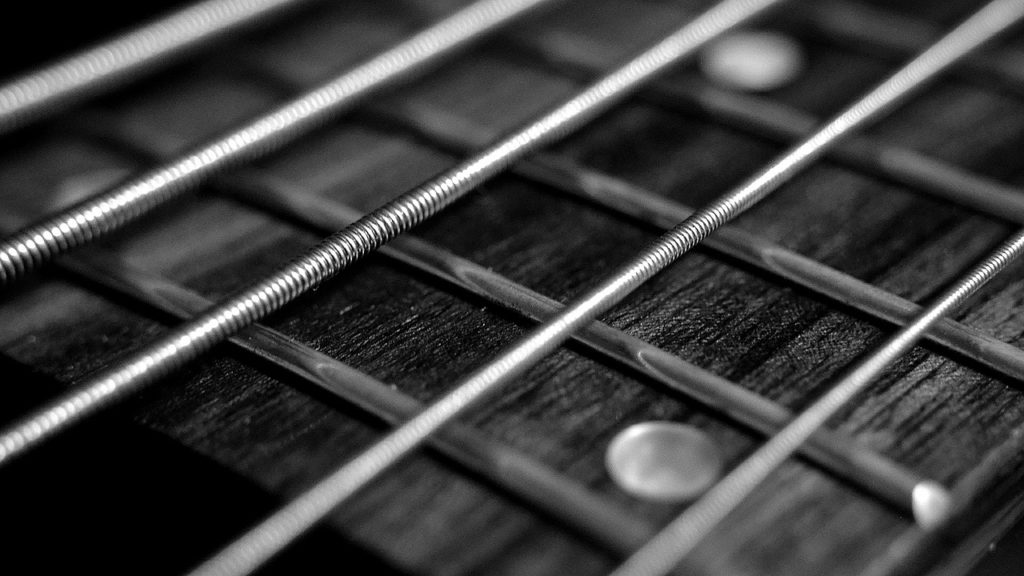
Another important factor for beginners is the size of the fret-board/neck. Guitar players with smaller hands should look for a guitar that offers a narrow and shallow neck construction. While a person with wider hands should look for a beefier neck.
There are three main types of necks:
- Bolt-on – Bolted on the guitar body as the name suggests and is much more cost effective during construction. It also makes replacements and repairs much easier. However, it also has less sustain and resonance of other neck types.
- Set neck – They are set in the body and glued in place. It is a more stable option and offers more sustain and resonance. The downside is repairs are much harder to handle.
- Neck through – These extend the entire length of the guitar. This offers more stability and greater resonance and sustain. While repairs are also more difficult, with improved stability, repairs are less likely to be needed.
For more information on neck types, check out www.fender.com
Bridges and tuners
There are multiple varieties and if you wish to look more into then check out the following links with more in depth buyer guides. Otherwise, for a beginner the differences will be subtle and may not matter to someone new to learning.
Conclusion
Buying a beginners first guitar should be done right and I hope this guide/review has helped. The 5 guitars listed above were picked based on numerous qualities, a primary one being affordability. All of them are cost-efficient and will work perfectly for a beginner. If there are any improvements, please comment below or reach us on our contact page. Thank you!
License for icons in infographic
